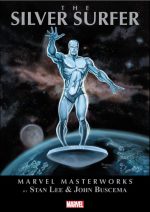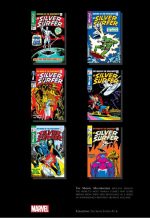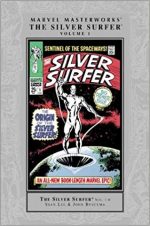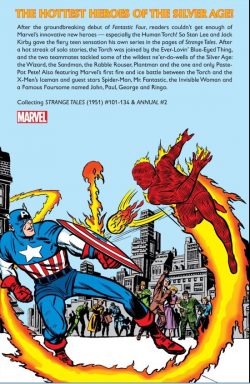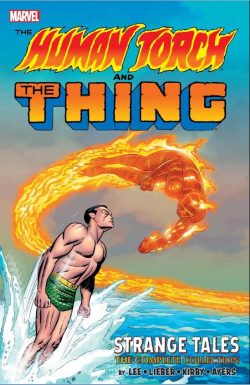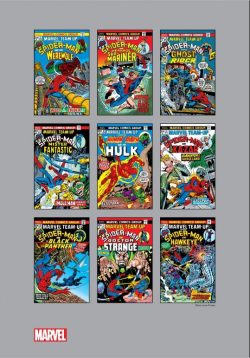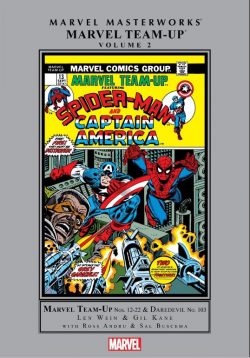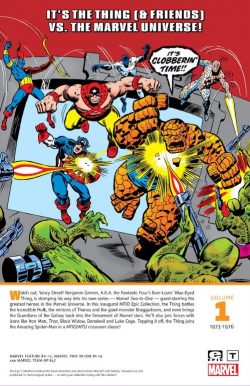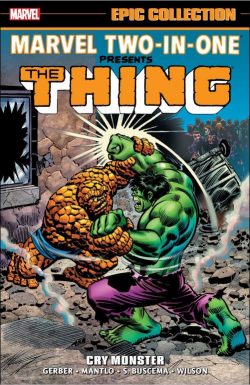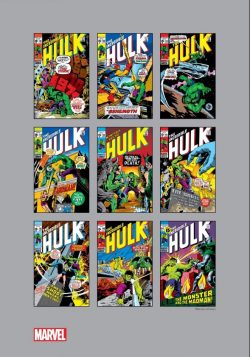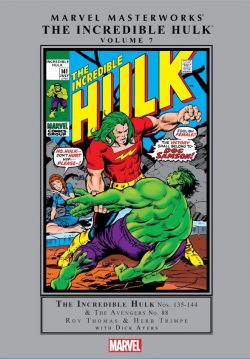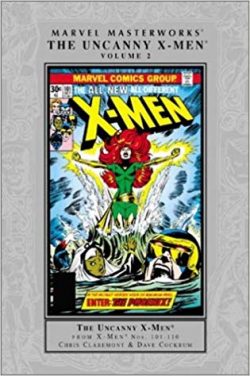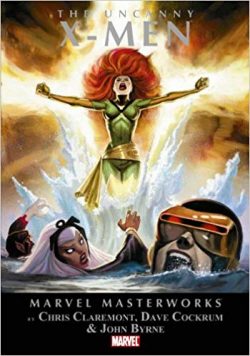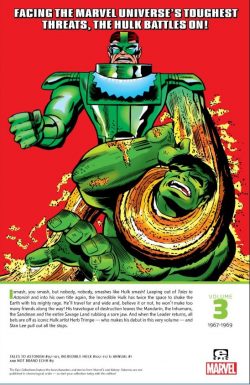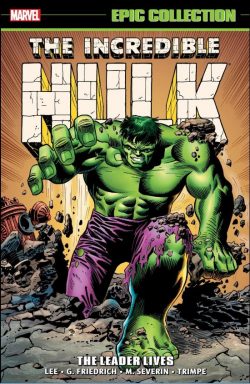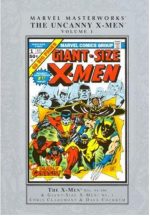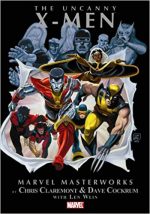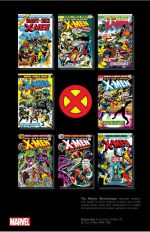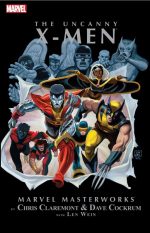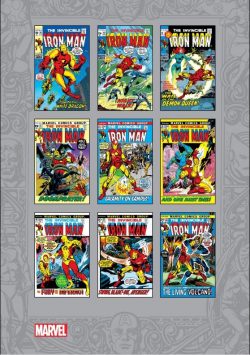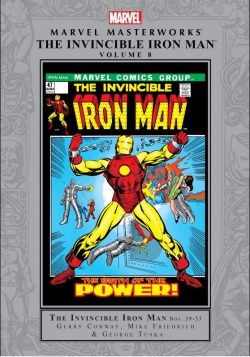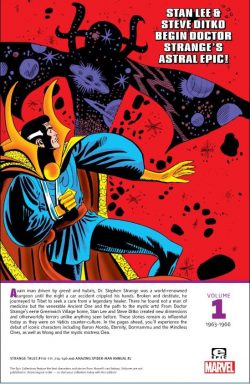
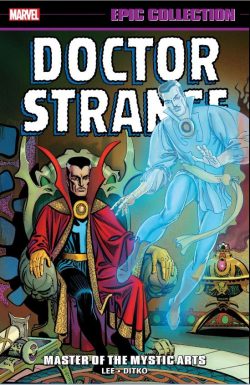
By Stan Lee & Steve Ditko, Bill Everett, with Don Rico, Roy Thomas, Dennis O’Neil, George Roussos & various (Marvel)
ISBN: 978-1-3029-1138-6
We lost some grand masters of our art form this year, including arguably the biggest name left in the pantheon in American comics, Stan Lee. Also gone is certainly the most influential and least understood of American comics’ true greats: Steve Ditko. Despite their infamous acrimonious later working relationship, Lee & Ditko literally made magic together.
Here’s a recently-released collection with them at their very best and most groundbreaking…
When the budding House of Ideas introduced a warrior wizard to their burgeoning pantheon in the summer of 1963 it was a bold and curious move. Bizarre adventures and menacing monsters were still incredibly popular but mention of magic or the supernatural – especially vampires, werewolves and their eldritch ilk – were harshly proscribed by a censorship panel which dictated almost all aspects of story content.
At this time – almost a decade after a public witch hunt led to Senate hearings – all comics were ferociously monitored and adjudicated by the draconian Comics Code Authority. Even though some of the small company’s strongest sellers were still mystery and monster mags, their underlying themes and premises were almost universally mad science and alien wonders, not necromantic or thaumaturgic horrors.
That might explain Stan Lee’s low-key introduction of Steve Ditko’s mystic adventurer: an exotic, twilit troubleshooter inhabiting the shadowy outer fringes of rational, civilised society.
Capitalising on of the runaway success of Fantastic Four, Lee had quickly spun off the youngest, most colourful member of the team into his own series, hoping to recapture the glory of the 1940s when the Human Torch was one of the company’s untouchable “Big Three†superstars.
Within a year of FF #1, anthology title Strange Tales became home for the blazing boy-hero (beginning with issue #101, cover-dated October 1962): launching Johnny Storm on a creatively productive but commercially unsuccessful solo career.
Soon after, in Tales of Suspense #41 (May 1963) current sensation Iron Man battled a crazed technological wizard dubbed Doctor Strange, and with the name successfully and legally in copyrightable print (a long-established Lee technique: Thorr, The Thing, Electro, Magneto and the Hulk had been disposable Atlas “furry underpants monsters†long before they became in-continuity Marvel characters), preparations began for a new and truly different kind of hero.
The company had already – recently – published a quasi-mystic precursor: balding, trench-coated savant Doctor Droom – later rechristened (or is that re-paganed?) Dr. Druid – had an inconspicuous short run in Amazing Adventures (volume 1 #1-4 & #6: June-November 1961).
He was a psychiatrist, sage and paranormal investigator tackling everything from alien invaders to Atlanteans (albeit not the ones Sub-Mariner ruled). Droom was subsequently retro-written into Marvel continuity as an alternative candidate and precursor for Stephen Strange‘s ultimate role as Sorcerer Supreme…
Nevertheless, after a shaky start, the Marvel Age Master of the Mystic Arts became an unmissable icon of the cool counter-culture kids who saw in Ditko’s increasingly psychedelic art echoes and overtones of their own trippy explorations of other worlds and realms…
That might not have been the authors’ intentions but it certainly helped keep the mage at the forefront of Lee’s efforts to break comics out of the kids-stuff ghetto…
This enchanting full colour paperback compilation – also available as a digital download – collects the mystical portions of Strange Tales #110, 111 and 114-146 plus a titanic team-up from Amazing Spider-Man Annual #2; spanning July 1963 to July 1966. Moreover, although the Good Doctor was barely cover-featured until issue #130, it also magnanimously includes every issue’s stunning frontage, thus offering an incredible array of superbly eye-catching Marvel masterpieces from the upstart outfit’s formative heyday by Jack Kirby, Dick Ayers, Bob Powell, John Severin and others.
Thus, without any preamble, our first meeting with the man of mystery comes courtesy of a quiet little chiller which has never been surpassed for sheer mood and imagination.
Lee & Ditko’s ‘Doctor Strange Master of Black Magic!’ debuted at the back of Strange Tales #110 and saw a terrified man troubled by his dreams approach an exceptional consultant in his search for a cure…
That perfect 5-page fright-fest introduces whole new realms and features deceit, desperation, double-dealing and the introduction of both a mysterious and aged oriental mentor and devilish dream demon Nightmare in an unforgettable yarn that might well be Ditko’s finest moment…
A month later in #111 the good Doctor was back, ‘Face-to-Face with the Magic of Baron Mordo!’ which sensibly introduced a player on the other side…
The esoteric duel with such an obviously formidable foe established Strange as a tragic solitary guardian tasked with defending the world from supernatural terrors and uncanny encroachment whilst introducing his most implacable enemy, a fellow sorcerer with vaulting ambition and absolutely no morals. In the astounding battle that ensued, it was also firmly confirmed that Strange was the smarter man…
Then things went quiet for a short while until the letters started coming in…
Strange Tales #114 (November 1963) was one of the most important issues of the era. Not only did it highlight the return of another Golden Age hero – or at least a villainous facsimile of him – by Lee, Kirby & Ayers. Here’s a quote from the last panel. “You guessed it! This story was really a test! To see if you too would like Captain America to Return! As usual, your letters will give us the answer!†We all know how that turned out…
Nevertheless, for many of us the true treasure trove here was the fabulously moody resurrection of Doctor Strange: permanently installing an eccentric and baroque little corner of the growing unified universe where Ditko could let his imagination run wild…
With #114, the Master of the Mystic Arts took up monthly residence behind the Torch as ‘The Return of the Omnipotent Baron Mordo!’ (uncredited inks by George Roussos) finds the Doctor lured to London and into a trap, only to be saved by unlikely adept Victoria Bentley: an abortive stab at a romantic interest who would periodically turn up in years to come.
The forbidding man of mystery is at last revealed in all his frail mortality as Strange Tales #115 offered ‘The Origin of Dr. Strange’, disclosing how Stephen Strange was once America’s greatest surgeon. A brilliant man, yet greedy, vain and arrogant, he cares nothing for the sick except as a means to wealth and glory. When a self-inflicted, drunken car-crash ends his career, Strange hits the skids.
Then, fallen as low as man ever could, the debased doctor overheard a barroom tale which led him on a delirious odyssey or, perhaps more accurately, pilgrimage to Tibet, where a frail and aged mage changed his life forever. It also showed his first clash with the Ancient One‘s other pupil Mordo: thwarting a seditious scheme and earning the Baron’s undying envious enmity…
Eventual enlightenment through daily redemption transformed Stephen the derelict into a solitary, dedicated watchdog for at the fringes of humanity, challenging all the hidden dangers of the dark on behalf of a world better off not knowing what dangers lurk in the shadows…
‘Return to the Nightmare World!’ sees the insidious dream predator trapping earthly sleepers in perpetual slumber until the doubtful authorities asked Strange to investigate. The hero’s invasion of his oneiric enemy’s stronghold is a masterpiece of moody suspense and is followed here by ‘The Many Traps of Baron Mordo!’: apparently showing the malevolent mage devising an inescapable doom, which once more founders after Strange applies a little logic to it…
The wildness and infinite variety of Strange’s universe offered Ditko tremendous opportunities to stretch himself visually and as plotter of the stories. In ST #118 the Master of Magic travels to Bavaria to combat ‘The Possessed!’, finding humans succumbing to extra-dimensional invaders neither fully mystic or mundane, whilst ‘Beyond the Purple Veil’ has Strange rescuing burglars who have stolen one of his deadly treasures from ray-gun wielding slaver-tyrants…
Strange Tales #120 played with the conventions of ghost stories as a reporter vanishes during a live broadcast from ‘The House of Shadows!’ and the concerned Doctor diagnoses something unworldly but certainly not dead…
Mordo springs yet another deadly trap in ‘Witchcraft in the Wax Museum!’ but is once again outsmarted and humiliated after stealing his rival’s body whilst Strange wanders the world in astral form…
Roussos returned as an uncredited inker for #122’s ‘The World Beyond’ wherein Nightmare nearly scores his greatest victory after the exhausted Strange falls asleep before uttering the nightly charm that protects from him from attack through his own dreams.
Strange hosts his first Marvel guest star in #123 whilst meeting ‘The Challenge of Loki!’ (August 1964 by Lee, Ditko & George Roussos as George Bell) as the god of Mischief tricks the earthly mage into briefly stealing Thor’s hammer before deducing where the emanations of evil he senses really come from…
Strange battles a sorcerer out of ancient Egypt to save ‘The Lady from Nowhere!’ from time-bending banishment and imprisonment, and performs similar service to rescue the Ancient One after the aged sage is kidnapped in ‘Mordo Must Not Catch Me!’, after which Roussos moves on whilst Lee & Ditko gear up for even more esoteric action.
Strange Tales #126 took the Master of the Mystic arts to ‘The Domain of the Dread Dormammu!’ as an extra-dimensional god seeks to subjugate Earth. In a fantastic realm Strange meets a mysterious, exotic woman who reveals the Dread One operates by his own implacable code: giving the overmatched Earthling the edge in the concluding ‘Duel with of the Dread Dormammu!’
This sees Earth saved, the Ancient One freed from a long-standing crippling curse and Strange awarded a new look and mystic weapons upgrade…
Restored to his homeworld and Sanctum Sanctorum in Greenwich Village, Strange then solves ‘The Dilemma of… the Demon’s Disciple!’ by saving a luckless truth-seeker from an abusive minor magician and – after a stunning pin-up by Ditko – defeats a demonic god of decadence stealing TV guests and execs in #129’s ‘Beware… Tiborro! The Tyrant of the Sixth Dimension!’ (scripted by Golden Age great Don Rico).
Doctor Strange got his first star cover slot for Strange Tales #130 to celebrate the start of an ambitious multi-part saga which would be rightly acclaimed one of the mystic’s finest moments.
‘The Defeat of Dr. Strange’ opens with an enigmatic outer-dimensional sponsor entering into a pact with Baron Mordo to supply infinite power and ethereal minions in return for the death of Earth’s magical guardian…
With the Ancient One assaulted and stuck in a deathly coma, Strange is forced to go on the run: a fugitive hiding in the most exotic corners of the globe as remorseless, irresistible forces close in all around him…
A claustrophobic close shave whilst trapped aboard a jetliner in ‘The Hunter and the Hunted!’ expands into cosmic high gear in #132 as Strange doubles back to his sanctum and defeats the returning Demon only to come ‘Face-to-Face at Last with Baron Mordo!’ Crumbling into weary defeat as the villain’s godly sponsor is revealed, the hero is hurled headlong out of reality to materialise in ‘A Nameless Land, A Timeless Time!’ before confronting tyrannical witch-queen Shazana.
Upon liberating her benighted realm, the relentless pursuit resumes as Strange re-crosses hostile dimensions to take the fight to his foes in ‘Earth Be My Battleground’.
Returning to the enclave hiding his ailing master, he gleans a hint of a solution in the mumbled enigmatic word “Eternity†and begins searching for more information, even as, in the Dark Dimension, a terrified girl attempts to sabotage Dread Dormammu’s efforts to empower Mordo…
As the world went super-science spy-crazy and Nick Fury Agent of S.H.I.E.L.D. took over the lead spot with Strange Tales #135, the Sixties also saw a blossoming of alternative thought and rebellion. Doctor Strange apparently became a confirmed favourite of the blossoming Counterculture Movement and its recreational drug experimentation subculture. With Ditko truly hitting his imaginative stride, it’s not hard to see why. His weirdly authentic otherworlds and demonstrably adjacent dimensions were just unlike anything anyone had ever seen or depicted before…
‘Eternity Beckons!’ when Strange is lured to an ancient castle where an old ally seeks to betray him and, after again narrowly escaping Mordo’s minions, the Mage desperately consults the aged senile Genghis in #136: a grave error in judgement. Once more catapulted into a dimension of deadly danger, Strange barely escapes a soul-stealing horror after discovering ‘What Lurks Beneath the Mask?’
Back on Earth and out of options, the Doctor is forced to test his strength against the Ancient One’s formidable psychic defences to learn the secret of Eternity in ‘When Meet the Mystic Minds!’ After barely surviving the terrible trial, he translates himself to a place beyond reality to meet the embodiment of creation in ‘If Eternity Should Fail!’
The quest for solutions or extra might bears little fruit and, as he despondently arrives on Earth, the Doctor finds his mentor One and his unnamed female friend prisoners of his worst enemies in anticipation of a fatal showdown…
Strange Tales #139 warns ‘Beware…! Dormammu is Watching!’, but as Mordo – despite being super-charged with the Dark Lord’s infinite energies – fails over and again to kill the Good Doctor, the Overlord of Evil loses all patience and drags the whole show into his home domain…
Intent on making a show of destroying his mortal nemesis, Dormammu convenes a great gathering before whom he will smash Strange in a duel using nothing but ‘The Pincers of Power!’ and is again bathed in ultimate humiliation as the mortal’s wit and determination result in a stunning triumph in concluding episode ‘Let There Be Victory!’
As the universes tremble, Doctor Strange wearily heads home, blithely unaware that his enemies have laid one last trap. The weary victor returns to his mystic Sanctum Sanctorum, unaware that his foes have boobytrapped his residence with mundane explosives…
Scripted by Lee and plotted and illustrated by Ditko, Strange Tales #142 reveals ‘Those Who Would Destroy Me!’ as Mordo’s unnamed disciples ready for one last stab at the Master of the Mystic Arts.
They would remain anonymous for decades, only gaining names of their own – Kaecillius, Demonicus and The Witch – upon their return in the mid-1980s. Here, however, they easily entrap the exhausted mage and imprison him with a view to plundering all his secrets. It’s a big mistake as, in the Roy Thomas dialogued sequel ‘With None Beside Me!’, Strange quickly outwits and subdues his captors…
In #144 Ditko & Thomas take the heartsick hero ‘Where Man Hath Never Trod!’ Although Dormammu was soundly defeated and humiliated before his peers and vassals, the demonic tyrant takes a measure of revenge by exiling Strange’s anonymous female collaborator to realms unknown. Now, as the Earthling seeks to rescue her while searching myriad mystic planes, he stumbles into a trap laid by the Dark One and carried out by devilish collector of souls Tazza…
On defeating the scheme, Strange returns to Earth and almost dies at the hands of a far weaker, but much sneakier wizard dubbed Mister Rasputin. The spy and swindler utilises meagre mystic gifts for material gain but is happy to resort to base brutality ‘To Catch a Magician!’ (scripted by Dennis O’Neil).
All previous covers had been Kirby S.H.I.E.L.D. affairs but finally, with Strange Tales #146, Strange and Ditko won their moment in the sun. Although the artist would soon be gone, the Good Doctor remained, alternating with Nick Fury’s team until the title ended.
Ditko & O’Neil presided over ‘The End …At Last!’ as a deranged Dormammu abducts Strange before suicidally attacking the omnipotent embodiment of the cosmos known as Eternity.
The cataclysmic chaos ruptures the heavens over infinite dimensions and when the universe is calm again both supra-deities are gone. Rescued from the resultant tumult, however, is the valiant girl Strange had loved and lost. She introduces herself as Clea, and although Stephen despondently leaves her, we all know she will be back…
This cosmic swansong was Ditko’s last hurrah. Issue #147 saw a fresh start as Strange went back to his Greenwich Village abode under the auspices of co-scripters Lee & O’Neil, with comics veteran Bill Everett suddenly and surprisingly limning the arcane adventures.
Before that though there are a few treats still in store, beginning with one last Lee/Ditko yarn to enthral and beguile: Although a little chronologically askew, it is very much a case of the best left until last…
In October 1965 ‘The Wondrous World of Dr. Strange!’ (from Amazing Spider-Man Annual #2) was the astonishing lead feature in an otherwise vintage reprint Spidey comicbook.
The entrancing fable unforgettably introduced the webslinger to arcane adventure and otherworldly realities as he teamed up with the Master of the Mystic Arts to battle power-crazed wizard Xandu in a phantasmagorical, dimension-hopping masterpiece involving ensorcelled zombie thugs and the purloined Wand of Watoomb.
After this story it was clear that Spider-Man could work in any milieu and nothing could hold him back… and the cross-fertilisation probably introduced many fans to Lee & Ditko’s other breakthrough series.
But wait, there’s even more! Wrapping up the proceeding is a selection of original art beginning with an unused pencil sketch of a master and student pinup plus a completed pinup published in 1967’s Marvel Collectors’ Item Classics #10 and the original art for it.
Following those is a contemporary T-shirt design, a cover gallery of Marvel Tales #1 and Doctor Strange Classics #1-4 (by John Byrne & Al Milgrom, including text pages by Roger Stern) all nicely rounded off by a re-presentation of previous Ditko collection covers modified by painters Dean White & Richard Isanove as well as Alex Ross’ epic Doctor Strange Omnibus cover.
Doctor Strange has always been the coolest of outsiders and most accessible fringe star of the Marvel firmament. This glorious grimoire is a magical method for old fans to enjoy his world once more and the perfect introduction for recent acolytes or converts created by the movie iteration to enjoy the groundbreaking work of two thirds of the Marvel Empire’s founding triumvirate at their most imaginative.
© 1963, 1964, 1965, 1966, 2018 Marvel Characters, Inc. All rights reserved.
